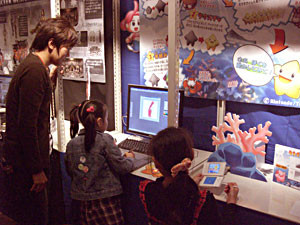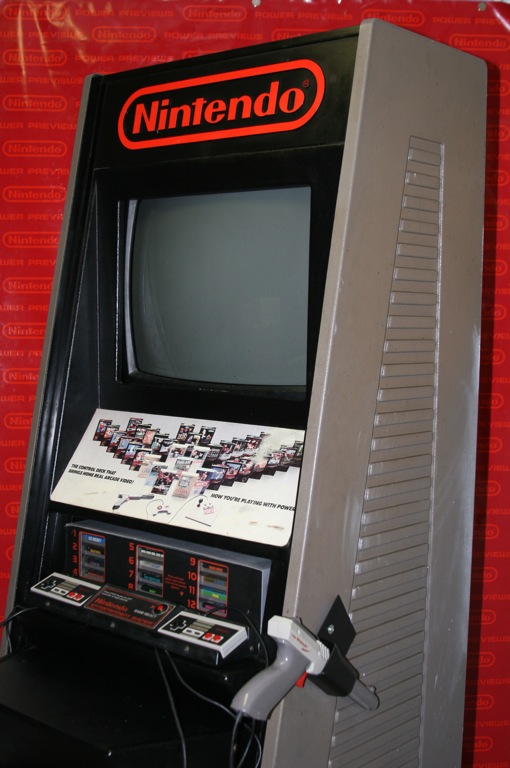Post by Evie ❤✿ on Apr 29, 2023 13:18:13 GMT -5
Discuss. There are actually lots of examples to cover, but for now I'll only focus on a few. I'd love to hear contributions to this list from other users too. ^^
Table games:
Postal Savings Game Zipang Travelers (郵便貯金ゲーム ジパング・トラベラーズ) was a table-top download game released by Jupiter and Dentsu as an experiment in April 1, 1997 only for subscribers and 300 households with fibre-optics. It was launched by Kansai Science City (based in Japan between Kyoto, Osaka, and Nara). The gameplay is like a children's dice game, and it was also released in association with the Ministry of Posts and Telecommunications Savings Bureau to encourage people to save money. The story is based around exploring Japan while saving money and there are various interesting mascots.



web.archive.org/web/19970726090053/http://www.jupiter.co.jp/game/Zipangu/index.htm
Sokudoku Nouryoku Training Game (サプリバ向け 速読能力トレーニングゲーム) was a 2006 successor to Denyusha's 2004 Flash-based Joint-Shiki Sokudoku Training Soft: Sokudoku Kyoushitsu (ジョイント式速読トレーニングソフト「速読教室」) game for Suppliba machines; a coined word for food ordering machines with a bonus video game. This variation was called Sokudoku Nouryoku Training Game, and cost a single payment of 105 yen (tax included). Nyauron is the main character and a cute yellow cat with pink ears.

web.archive.org/web/20170702073318/https://www.denyu-sha.co.jp/product.html
Museums:
Dream Machine: Creations Drawn at the NVM
Video I filmed about a machine in association with Sheffield, England's National Videogame Museum. I didn't get the chance to properly play this, but from how I remember there is a separate capture station, and players can draw their own creations and have them displayed.
TOSE Game Software Development Spot's unknown drawing system
In Japan at the Kyoto International Manga Museum TOSE ran an exhibit for Xbox 360, Playstation 3, and Nintendo DS. It was also a chance for them to again show off their own Densetsu no Stafy series, specifically the fifth game The Legendary Starfy, known in Japan as Densetsu no Stafy: Taiketsu! Daīru Kaizokudan (伝説のスタフィー たいけつ!ダイール海賊団) (Legendary Stafy Confrontation: Daīru's Pirate Squad).
Similar to the Dream Machine in Sheffield, of note apparently there was a computer to draw an image and it would be reflected in game.


kyotomm.hatenadiary.org/entry/20091024/1256367328
www.starfywiki.org/wiki/Game_Software_Development_Spot

Vehicles:
Nintendo Gateway System
This video by Lady Decade is about the variations of existing Nintendo consoles only intended to be added to aeroplane services.
There was a similar service for a rival company which I think Lady Decade mentioned in her video, but because my computer isn't relatively powerful it crashed my browser having several tabs, that and Discord open, so I'll edit with the name if I find it. (OK I found it)
Sega Mega Jet
The similar service Lady Decade mentioned was Sega's Mega Jet. According to Sega Wiki Fandom it was another, 1994 portable variation of the Sega Mega Drive for aeroplanes for Japan Airlines flights. It connected to a small armrest monitor. In March 10, 1994 Sega released a consumer version for US $123 with an added mono DIN plug cord and AC adapter.
It became the basis of the 1995 Genesis Nomad/Sega Nomad only for North America.
sega.fandom.com/wiki/Mega_Jet
sega.fandom.com/wiki/Nomad

Kuruma de DS
By Denso-Ten and Nintendo in collaboration with Toyota and Honda for Japanese car systems with a GPS. Toyota's ECLIPSE AVN-ZX02i and Honda's "FIT" series. You could play Nintendo DS in the car and take quizzes, take map notes, and gather tourist information. A little like Pokémon GO before Pokémon GO. Additionally, it was:
*One of a few Nintendo games with a Mii Maker before Nintendo 3DS (others were Tomodachi Collection, Personal Trainer Walking(?), and Yosuke Ide no Kenkou Mahjong DSi for Nintendo DSi) though the Mario Artist series and the cancelled Stage Debut had something like it too.
*One of a few Nintendo DS games with voice synthesis. Others were Nintendo's original Tomodachi Collection game and the mail order only release Communication Aid: Anone ♪ DS by Three-Ten and Vamos to help people with communication difficulties and people on the autism spectrum.
Demo stations:
Nintendo Entertainment System M82
You could play up to 12 pre-selected cartridges with a play time limit of 30 seconds, 3, 6 or 128 minutes. Known for its interesting menu theme music. A prototype of it "Glorious March" was released by composer Hirokazu Tanaka in the 2021 "Lost Tapes" album.

1991? Blue Planet Software "Inaro" Tech Demo
I explained this for The Cutting Room Floor and thanks to this forum's own nocturnal YL for context about Nintendo Puzzle Collection and thanks to The Mushroom Kingdom for the Wii Virtual Console information.
"Hermetica was based on a gameplay concept and demo known as Inaro (1991). In the credits of Nintendo Puzzle Collection for Nintendo GameCube it explains that the copyright and trademark was held 1991-2003 Intellectual Property Consultants, Inc. under license by Nintendo. In the Wii Virtual Console manual it also says "INARO™ Game concept ©1991-2008 Intellectual Property Consultants, Inc., used, under license, by Nintendo.
Fortunately, Wayback Machine had archived a video of a Inaro demo from the official Blue Planet Software website, captured in 2007. "
web.archive.org/web/20070918160554/http://www.blueplanetsoftware.com/inaro.html
Other prototypes exist, later for Hermetica and Yoshi's Cookie but for this thread I'll only focus on Inaro-like games and Hermetica before Yoshi's Cookie.

Added by Rlan from archive.org/details/micomBASIC_1993-03
Inaro 2

Table games:
Postal Savings Game Zipang Travelers (郵便貯金ゲーム ジパング・トラベラーズ) was a table-top download game released by Jupiter and Dentsu as an experiment in April 1, 1997 only for subscribers and 300 households with fibre-optics. It was launched by Kansai Science City (based in Japan between Kyoto, Osaka, and Nara). The gameplay is like a children's dice game, and it was also released in association with the Ministry of Posts and Telecommunications Savings Bureau to encourage people to save money. The story is based around exploring Japan while saving money and there are various interesting mascots.



web.archive.org/web/19970726090053/http://www.jupiter.co.jp/game/Zipangu/index.htm
Sokudoku Nouryoku Training Game (サプリバ向け 速読能力トレーニングゲーム) was a 2006 successor to Denyusha's 2004 Flash-based Joint-Shiki Sokudoku Training Soft: Sokudoku Kyoushitsu (ジョイント式速読トレーニングソフト「速読教室」) game for Suppliba machines; a coined word for food ordering machines with a bonus video game. This variation was called Sokudoku Nouryoku Training Game, and cost a single payment of 105 yen (tax included). Nyauron is the main character and a cute yellow cat with pink ears.

web.archive.org/web/20170702073318/https://www.denyu-sha.co.jp/product.html
Museums:
Dream Machine: Creations Drawn at the NVM
Video I filmed about a machine in association with Sheffield, England's National Videogame Museum. I didn't get the chance to properly play this, but from how I remember there is a separate capture station, and players can draw their own creations and have them displayed.
TOSE Game Software Development Spot's unknown drawing system
In Japan at the Kyoto International Manga Museum TOSE ran an exhibit for Xbox 360, Playstation 3, and Nintendo DS. It was also a chance for them to again show off their own Densetsu no Stafy series, specifically the fifth game The Legendary Starfy, known in Japan as Densetsu no Stafy: Taiketsu! Daīru Kaizokudan (伝説のスタフィー たいけつ!ダイール海賊団) (Legendary Stafy Confrontation: Daīru's Pirate Squad).
Similar to the Dream Machine in Sheffield, of note apparently there was a computer to draw an image and it would be reflected in game.


kyotomm.hatenadiary.org/entry/20091024/1256367328
www.starfywiki.org/wiki/Game_Software_Development_Spot

Vehicles:
Nintendo Gateway System
This video by Lady Decade is about the variations of existing Nintendo consoles only intended to be added to aeroplane services.
There was a similar service for a rival company which I think Lady Decade mentioned in her video, but because my computer isn't relatively powerful it crashed my browser having several tabs, that and Discord open, so I'll edit with the name if I find it. (OK I found it)
Sega Mega Jet
The similar service Lady Decade mentioned was Sega's Mega Jet. According to Sega Wiki Fandom it was another, 1994 portable variation of the Sega Mega Drive for aeroplanes for Japan Airlines flights. It connected to a small armrest monitor. In March 10, 1994 Sega released a consumer version for US $123 with an added mono DIN plug cord and AC adapter.
It became the basis of the 1995 Genesis Nomad/Sega Nomad only for North America.
sega.fandom.com/wiki/Mega_Jet
sega.fandom.com/wiki/Nomad

Kuruma de DS
By Denso-Ten and Nintendo in collaboration with Toyota and Honda for Japanese car systems with a GPS. Toyota's ECLIPSE AVN-ZX02i and Honda's "FIT" series. You could play Nintendo DS in the car and take quizzes, take map notes, and gather tourist information. A little like Pokémon GO before Pokémon GO. Additionally, it was:
*One of a few Nintendo games with a Mii Maker before Nintendo 3DS (others were Tomodachi Collection, Personal Trainer Walking(?), and Yosuke Ide no Kenkou Mahjong DSi for Nintendo DSi) though the Mario Artist series and the cancelled Stage Debut had something like it too.
*One of a few Nintendo DS games with voice synthesis. Others were Nintendo's original Tomodachi Collection game and the mail order only release Communication Aid: Anone ♪ DS by Three-Ten and Vamos to help people with communication difficulties and people on the autism spectrum.
Demo stations:
Nintendo Entertainment System M82
You could play up to 12 pre-selected cartridges with a play time limit of 30 seconds, 3, 6 or 128 minutes. Known for its interesting menu theme music. A prototype of it "Glorious March" was released by composer Hirokazu Tanaka in the 2021 "Lost Tapes" album.

1991? Blue Planet Software "Inaro" Tech Demo
I explained this for The Cutting Room Floor and thanks to this forum's own nocturnal YL for context about Nintendo Puzzle Collection and thanks to The Mushroom Kingdom for the Wii Virtual Console information.
"Hermetica was based on a gameplay concept and demo known as Inaro (1991). In the credits of Nintendo Puzzle Collection for Nintendo GameCube it explains that the copyright and trademark was held 1991-2003 Intellectual Property Consultants, Inc. under license by Nintendo. In the Wii Virtual Console manual it also says "INARO™ Game concept ©1991-2008 Intellectual Property Consultants, Inc., used, under license, by Nintendo.
Fortunately, Wayback Machine had archived a video of a Inaro demo from the official Blue Planet Software website, captured in 2007. "
web.archive.org/web/20070918160554/http://www.blueplanetsoftware.com/inaro.html
Other prototypes exist, later for Hermetica and Yoshi's Cookie but for this thread I'll only focus on Inaro-like games and Hermetica before Yoshi's Cookie.

Added by Rlan from archive.org/details/micomBASIC_1993-03
Inaro 2





